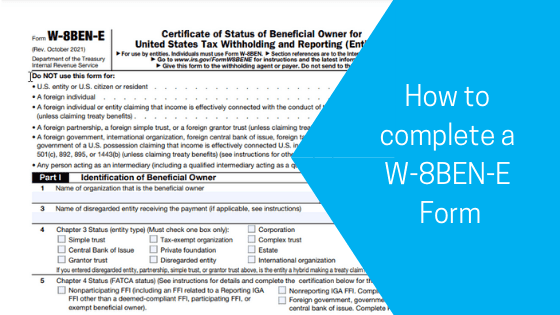If you trade with a customer in the US, you may be asked to complete a W-8 form before your customer will arrange payment of your invoice.
This article looks at the W-8 form in more detail and considers how a micro business would fill the W-8 form in.
What is a W-8 Form?
Essentially, the W-8 form is a self-certification form that you can provide your customer to declare that you as an entity (an individual or an incorporated business) are not US taxpayers and are not subject to US tax.
This allows your customer to pay the full value of your invoice/s and not withhold tax.
If you don’t provide this form to your US client, they may withhold some of the balance that they owe you in order to pay tax on your behalf to the IRS.
The full and very official name of the W-8 form is a certificate of Foreign Status of Beneficial Owner for United States Tax Withholding and Reporting (individuals ) / (Entities).
What types of form might I see?
A W-8BEN is issued to an individual – usually contractors, consultants or investors in US companies.
A W-8BEN-E is issued to an entity – a limited company that has delivered services to a US company.
Since the majority of our clients have to complete the W-8BEN-E, this is the form we will look at in detail today
How do I complete the W-8?
Part 1
Q1 and Q2 asks for your basic company details, your registered company name and the country of incorporation. Hopefully, these are quite straightforward!
![]()
Q3 asks for the ‘name of disregarded entity receiving the payment (if applicable, see instructions)’. This is not relevant to you as we are applying for exemption as a company so you can ignore that field.
![]()
Q4 asks you to define the type of entity that is receiving the payment. This will be ‘Corporation ‘if you are trading as a UK limited company.

Q5 asks you to define the FATCA (Foreign Account Tax Compliance Act) status of the entity receiving the payment. Most UK SME’s will be an Active NFFE (Non-Financial Foreign Entity) – basically a trading entity, not a bank, investment or publicly traded entity.

Q6 asks for your permanent residence – we usually put the registered office address here.

Q7 asks for your mailing address, this is where the business can be found – we usually put the trading address here IF it is different to the residence address.

Q8 and Q9 ask for an EIN (Employer Identification Number) or an FTIN (Foreign Tax Identification Number)
Foreign entities that are not individuals (i.e., foreign corporations, etc.) and that are required to have a federal Employer Identification Number (EIN) in order to claim an exemption from withholding because of a tax treaty (claimed on Form W-8BEN), need to apply directly to the IRS to get the EIN number.
Yes, if you are selling your services to a US customer – then you DO need an EIN. You need to be registered on the IRS’s system and recognised as a overseas business taxpayer in order to claim exemption from US tax.
Getting an EIN can be a bit tricky.
- The faster and most efficient way to get your EIN, is to call the IRS and talk through the SS-4 application form – that you should fill in before the call. The IRS will take you step through the form fields. Once your application has been reviewed and accepted by the IRS Agent – they will provide the EIN, which will allow you to complete the W-8 BEN-E.
- Form SS-4 Application for Employer Identification Number – Follow the instructions carefully when you complete this form!
- IRS International Applicants Phone Number: 001-267-941-1099. Getting hold of the IRS is as tricky as calling HMRC so be patient!
Q10 can be ignored
![]()
Part II Disregarded Entity or Branch Receiving Payment
Part II can be ignored. We have already established that you are a corporation not a disregarded entity.
The IRS says that “an LLC with only one member is treated as an entity disregarded as separate from its owner for income tax purposes,…unless it…affirmatively elects to be treated as a corporation..” So the IRS treats a sole director/shareholder LLC as a sole trader for tax purposes. That does complicate matters slightly for a single director / shareholder company but we will come back to that later!

Part III Claim of Tax Treaty Benefits
Part III asks you to claim for tax treaty benefits. You are claiming a 0% withholding tax to be applied to the payment being made to you by your supplier. Each country has entered into a tax treaty with the US. Typically you will need to identify which Article in the treaty you are claiming 0% tax to be applied.

You can find the USA-UK Treaty here.
The most common Articles we find our clients use for their W-8BEN-E forms are:
- Article 7 – Business Profits – 0%
- Article 12 – Royalties – 0%
This statement is key – so make sure it is included on your form! “The company is resident in the United Kingdom and does not carry on business in the United States nor does it have a permanent establishment in the United States”
Parts IV to XXIX
You can ignore each of these sections – they do not need to be completed – with the exception of Part XXV – Q39 which must be cjhecked.
Part XXX Certification
This needs to be signed off by a director of the business or an authorised individual as named in section 1. For a small business, this would usually be the director.
Once signed – you would keep the W-8 BEN-E on file and send a copy of the signed form to a US customer who asked for it prior to making payment.
Complications for sole director/shareholder companies
The IRS says that “an LLC with only one member is treated as an entity disregarded as separate from its owner for income tax purposes,…unless it…affirmatively elects to be treated as a corporation..” So the IRS treats a sole director/shareholder LLC as a sole trader for tax purposes.
The W-8BEN-E – is an application for your company to be exempted from US tax on trading income under the US:UK tax treaty. This is given to your US customer and held by them on file. It is never sent to the IRS unless requested during a compliance visit.
The SS-4 form – is an application for a tax identification number that ensures that you are registered with the IRS as an entity. You must be registered with the IRS in order to be able to claim an exemption under the tax treaty. During your phone interview to complete the SS-4 you will tell the operator that you are a single shareholder company so they would automatically register your tax status as an individual – disregarded entity.
Form 8832 – The IRS don’t recognise single director/owner companies as companies, instead they tax single director/owner companies as individuals (disregarding the entity) on their personal tax return UNLESS they elect to be taxed as companies not individuals. So the purpose of the 8832 form is to reclassify a single director/owner company as the company (not the individual) in the eyes of the IRS so that you can claim your exemption under the treaty as a company rather than as an individual. This form then needs to be live signed and sent to the IRS so they have a copy on their records to support your EIN application.
We know this can be quite tricky,
so we have some resources here that will help you.
Our Done-In A Day Masterclass, is a 1 hour webinar that will take you through every step you need to help you complete the form yourself. And yes, you can really get the form done in a day!
Our Check Service where you can send us your completed W-8BEN-E form and we will; check it for you.
Or our done for you Complete Service – *MOST POPULAR* if you would rather we completed the form for you, then you can choose our premium service.










